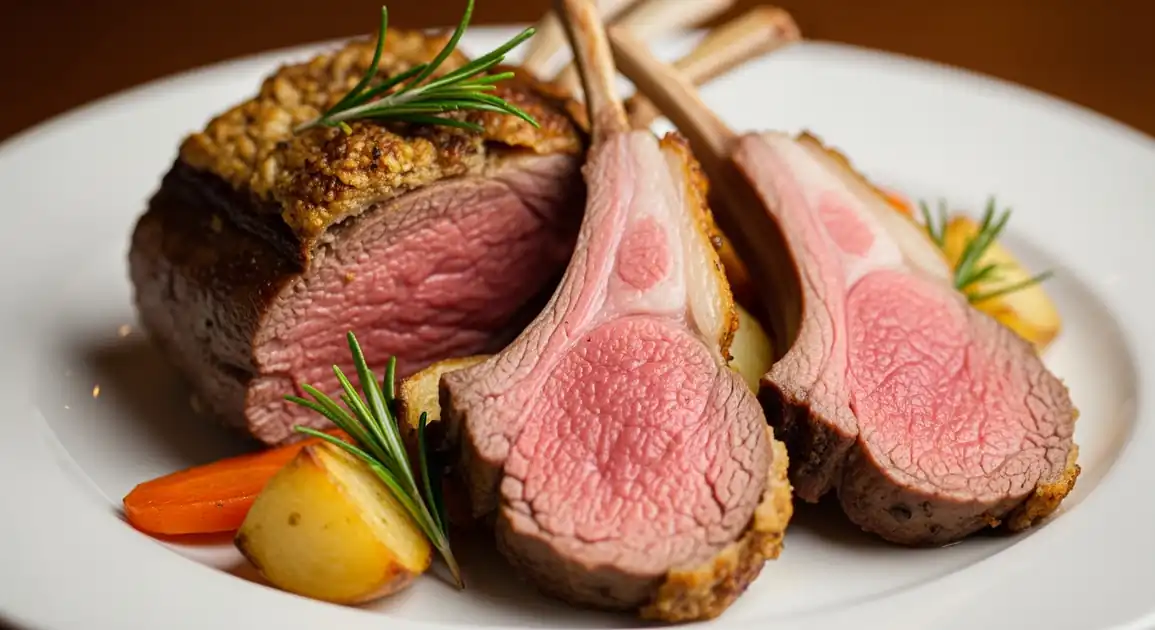Canterbury Lamb
Canterbury Lamb

Description
Canterbury Lamb is recognized nationwide as a premium product and is widely available in quality restaurants, gastropubs, and supermarkets across New Zealand. It's often highlighted on menus as a showcase of local produce, particularly in regions known for food and wine.
Dietary Information
Serving information
Serving style
Typically served plated as a main course in restaurants, often with roasted vegetables, potatoes, and a complementary sauce (jus, gravy, mint sauce).
Quick facts
Restaurant hours, typically Lunch (12 PM - 2 PM / 3 PM) and Dinner (6 PM - 9 PM / 10 PM).
Safety Tips
What to Look For
-
Dining at reputable restaurants/eateries
Established places with good reviews generally adhere to high food safety standards for sourcing, storage, and cooking meat.
-
Lamb cooked to order and served hot
Ensures the meat is freshly prepared or properly reheated to safe temperatures.
-
Clear communication about desired doneness
Ensure the kitchen understands your preference (e.g., medium-rare, medium, well-done) to cook it appropriately.
-
Knowledgeable staff
Staff who can answer questions about the source, cut, and preparation inspire confidence.
What to avoid
-
Lamb served significantly undercooked from requested temperature
While rare lamb is consumed, ensure it meets at least your requested internal temperature for safety and preference.
-
Establishments with poor hygiene ratings or reviews
Avoid places with known cleanliness issues, which increases food safety risks.
-
Buffet lamb dishes not held at proper hot temperature
Meat held in the 'danger zone' (between 5°C and 60°C) can allow bacteria to grow. Ensure buffet food is steaming hot.
-
Dishes where the lamb seems reheated multiple times or old
Affects quality and potentially safety. Freshly prepared is best.
Price information
Price range
Budget tips
- Restaurant main courses featuring Canterbury Lamb typically range from 35-55 NZD, potentially higher for premium cuts/venues.
- Gastropubs might offer slightly more budget-friendly options compared to fine dining.
- Look for set menus or lunch specials which might feature lamb.
- Supermarket prices for raw Canterbury Lamb are premium compared to standard lamb.
Value indicators
- Menu specifically states 'Canterbury Lamb'.
- Cooked perfectly to the requested doneness.
- Tender, juicy meat with good flavour.
- Well-executed accompaniments and sauce.
Where to Find This Dish
Fine Dining Restaurants
Showcased as a premium ingredient nationwide.
Major cities, Tourist regions, Luxury lodges
Dinner
Winery Regions (e.g., Marlborough, Hawke's Bay, Central Otago)
Frequently featured at winery restaurants, paired with local wines.
Wineries with restaurants
Lunch, Dinner
Gastropubs
Good quality pubs focusing on food often serve excellent lamb dishes.
Cities and towns
Lunch, Dinner
Vendor Tips
- Look for menus highlighting local sourcing.
- Ask staff for wine pairing recommendations (often a local Pinot Noir).
- Confirm preparation method and sides when ordering.
How to Order
Regional Variations
-
Roasted Lamb Rack
(Roasted Lamb Rack)
A premium cut, often 'French-trimmed', roasted (usually medium-rare) and served sliced.
-
Roast Leg of Lamb
(Roast Leg of Lamb)
A classic preparation, often slow-roasted until tender, served sliced with pan juices or gravy.
-
Grilled Lamb Chops / Cutlets
(Grilled Lamb Chops / Cutlets)
Smaller cuts, quick-grilled, often served with simple sides or salads.
-
Braised Lamb Shanks
(Braised Lamb Shanks)
Lamb shanks slow-cooked in liquid (often red wine based) until falling off the bone tender.
-
Lamb Rump
(Lamb Rump)
A flavourful cut, often pan-roasted or grilled, typically served medium-rare.
Cultural context
History
New Zealand has a long and significant history of sheep farming, becoming a major global exporter. The Canterbury Plains, with their expansive grasslands and favourable climate, proved ideal for raising sheep. Over decades, farmers in the region focused on breeding and feeding practices that yielded superior quality lamb, establishing the 'Canterbury Lamb' name as a benchmark for excellence.
Local significance
Lamb is a cornerstone of New Zealand's agricultural identity and cuisine. Canterbury Lamb represents the pinnacle of quality in this sector, a source of national pride.
Eating customs
- Eaten with knife and fork.
- Medium-rare is a common preference, but all doneness levels are acceptable.
- Often paired with robust red wines like Pinot Noir or Merlot.